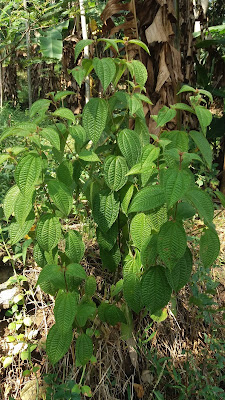Koster's Curse, Located in Sumedang, Indonesia
Description
Classification
Koster's Curse is a perennial shrub that can grow to a height of 5 m in moist, shady conditions (Biosecurity Queesland, 2016). The skin of stems, leaves and fruits are hairy. The fruit is edible. The colour of ripe fruit is purple, and the raw fruit is green.
Classification
Kingdom : Plantae - Plants
Subkingdom : Tracheobionta -Vascular plants
Superdivision : Spermatophyta - Seed plants
Superdivision : Spermatophyta - Seed plants
Division : Magnoliophyta - Flowering plants
Subdivision : Angiospermae -Seed encloses plants
Class : Magnoliopsida - Dicotyledons
Order : Myrtales
Family : Melastomataceae
Genus : Clidemia
Species : Clidemia hirta
Synonym(s)
Melastoma elegans Aublet
Popular Names
- Local Name(s): Harendong Bulu (Bulu=hair, because it's hairy)
- Common Name(s): Soapbush, Koster's Curse (English)
Habitat
Terrestrial
Distribution
C. hirta originated in Central and South America, while it is widely distributed. It is also native to the Caribbean island (Wester and Wood, 1997 in CABI, 2018). It is now in a large number of tropical countries and particularly in oceanic islands, and it is likely to be under-record (CABI, 2018). It is a serious weed on a number of tropical oceanic islands such as Malaysia, Singapore, Brunei, Indonesia, Papua New Guinea, Fiji, Samoa and Hawaii. It spread by birds that eating the berries, feral pigs, water and human intervention, such as potting material and mud on machinery or vehicles (Biosecurity Queesland, 2016).
Management
We can control the Koster's Curse by manual method, chemistry control, or both. Manual method is using a small hoe, we dig it to its root. This method can be used four times a year (*plant that are five years old) or three times a year (*plant that are six years old or more). While the Chemistry control is used herbicide. This method can be done two times a year. The last, we can combine manual and chemistry method, two times in the year by manual method and two times in the year by chemistry method (*plant that are three years old). The plant that is four years old and more is done one time in the year by a manual method and two times in the year by chemistry method (Pahan, 2007).
Management
We can control the Koster's Curse by manual method, chemistry control, or both. Manual method is using a small hoe, we dig it to its root. This method can be used four times a year (*plant that are five years old) or three times a year (*plant that are six years old or more). While the Chemistry control is used herbicide. This method can be done two times a year. The last, we can combine manual and chemistry method, two times in the year by manual method and two times in the year by chemistry method (*plant that are three years old). The plant that is four years old and more is done one time in the year by a manual method and two times in the year by chemistry method (Pahan, 2007).
Utilization
It’s used as a traditional medicinal plant. In
Indonesia the leaves are used to treat wounds. It also used for removing fish
mucus, and removing the bitter taste of papaya leaves (Rusyana,
2011). In Madagascar it’s used for Diarrhea, malaria, stomach-ache (Rakotoarivelo
et al, 2015). Furthermore, C. hirta leaves
extract has allelopathy effect, which has the potential to become herbicide (Ismaini and Lestari,
2015).
Pharmacology
It contains antibacterial (Dianita, 2011).
Toxicity
Plant in family Melastomataceae contains toxic tannins; causes hepatitis, nephrosis, and weight loss (Medical Dictionary,-).
References
- Biosecurity Queensland. 2016. Koster's Curse. Department of Agriculture and Fisheries.
- CABI. 2018. Clidemia hirta (Koster's Curse). Accessed on 09-08-2018.
- Dianita, R. 2011. Antibacterial Activity of Different Extracts of
Clidemia hirta (L.) D. Don leaves. Planta Medica 77 (12).
- Ismaini, L., and A. Lestari. 2015. Allelophatic potential of Clidemia hirta for herbicide usage. PROS SEM MASY BIODIV INDON 1 (6): 1467-1471.
- Medical Dictionary by Farlex. -. Climedia hirta. Accessed on 09-08-2018.
- Pahan, Iyung. 2007. Paduan Lengkap Kelapa Sawit. Jakarta : Penebar Swadaya.
- Rakotoarivelo, N. H., Rakotoarivony, F., Ramarosandratana, A. V., Jeannoda, V. H., Kuhlman, A. R., Randrianasolo A., and Rainner W. Bussman. 2015. Medicinal plants used to treat the most frequent diseases encountered in Ambalabe rural community, Eastern Madagascar. Journal of Ethnobiology and Ethnomedicine
- Rusyana, Yaya. 2011. Harendong Bulu (Clidemia Hirata (L.) D. Don). Accessed on 09-08-2018.

Comments
Post a Comment